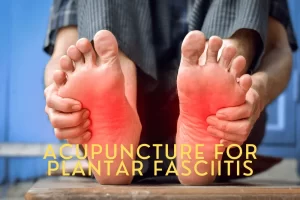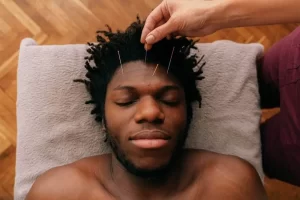Acupuncture for plantar fasciitis offers a promising alternative therapy for individuals seeking relief from this common foot condition. Plantar fasciitis, characterized by inflammation of the tissue connecting the heel bone to the toes, is the common cause of heel pain, impacting daily activities and mobility. Acupuncture, a traditional Chinese medicine practice involving the insertion of thin needles into specific points on the body, aims to alleviate pain and promote healing. This holistic approach targets the symptoms and addresses the underlying factors contributing to plantar fasciitis discomfort.
Symptoms Of Plantar Fasciitis
Plantar fasciitis manifests primarily through heel pain, typically worse in the morning or after prolonged periods of rest. The pain intensifies after standing or sitting for a while and then resuming activity. It often feels like a stabbing pain at the bottom of the foot, near the heel. The discomfort increases during physical activities like running or walking, and the affected heel tenders to the touch. In some cases, individuals with plantar fasciitis experience stiffness or limited mobility in the foot, making it challenging to walk or stand for extended periods.
What Are The Causes Of Plantar Fasciitis?
Plantar fasciitis commonly develops due to repetitive strain on the ligament that supports the arch of the foot. The primary causes include:
1. Overuse or Overload: Engaging in activities that put excessive stress on the plantar fascia, such as running, jumping, or standing for prolonged periods, can lead to micro-tears and inflammation.
2. Foot Structure: Certain foot structures, like high arches, flat feet, or abnormal walking patterns, can contribute to uneven distribution of weight and pressure on the plantar fascia, increasing the risk of injury.
3. Tightness: Tightness in the calf muscles or Achilles tendon can pull on the plantar fascia, causing inflammation and pain.
4. Obesity: Excess body weight places added stress on the feet and can exacerbate plantar fasciitis symptoms.
5. Age: Plantar fasciitis is more common in middle-aged individuals, possibly due to reduced elasticity and flexibility of the plantar fascia as we age.
How Acupuncture For Plantar Fasciitis Is Done?
The process involves inserting thin needles into specific points on the body to alleviate pain and promote healing. Here’s how it’s typically done:
1. Identify Trigger Points: Acupuncturists target trigger points associated with plantar fasciitis, such as PC7 and LI4, known for their analgesic properties.
2. Insert Needles: Fine needles are gently inserted into these trigger points, aiming to release muscle tension and reduce pain threshold.
3. Treatment Sessions: It typically involves multiple sessions spaced over weeks or months, depending on individual response and severity of symptoms.
4. Assessment and Adjustment: The acupuncturist may reassess the condition during subsequent sessions and adjust the treatment plan accordingly.
5. Combined Approach: Acupuncture is used alone or in conjunction with other therapies like massage or physical therapy for enhanced effectiveness.
Benefits Of Acupuncture Treatment For Plantar Fasciitis
Acupuncture offers several benefits for individuals suffering from plantar fasciitis:
1. Pain Relief: Acupuncture has been shown to significantly reduce pain levels in patients with plantar fasciitis, relieving discomfort and improving overall quality of life.
2. Reduced Inflammation: By targeting specific trigger points associated with plantar fasciitis, acupuncture helps decrease inflammation in the affected area, promoting healing.
3. Muscle Relaxation: The insertion of acupuncture needles helps release muscle tension and tightness, common contributors to plantar fasciitis symptoms.
4. Holistic Approach: Acupuncture addresses not only the symptoms but also the underlying imbalances in the body, aiming to restore harmony and overall well-being.
5. Minimal Side Effects: Compared to conventional treatments like steroid injections or surgery, acupuncture is generally safe and well-tolerated, with minimal risk of adverse effects.
How Many Acupuncture Sessions Are Needed For Plantar Fasciitis?
The number of acupuncture sessions needed varies depending on the individual’s condition and response to the treatment of plantar fasciitis. However, previous results have shown that significant improvement in pain can be observed after 4–8 weeks of treatment with acupuncture. Normally, acupuncture treatment five times a week for 2 weeks shows positive outcomes. It’s essential to consult with a qualified acupuncturist to determine the appropriate number of sessions based on your specific needs and response to treatment.
Combining Physical Therapy With Acupuncture For Plantar Fasciitis
Combining physical therapy with acupuncture for plantar fasciitis is often recommended by experts. Physical therapy helps strengthen and rehabilitate the affected area, while acupuncture can provide pain relief. Studies have shown positive therapeutic effects of acupuncture with physical therapy for plantar heel pain, including lower inflammation, improved mood, increased range of motion, and better pain relief. Therefore, this combination approach can be beneficial in managing plantar fasciitis effectively.
How To Prevent Plantar Fasciitis?
To prevent plantar fasciitis, you can follow these tips:
1. Wear Supportive Shoes: Go for shoes with good arch support and cushioning to reduce strain on the plantar fascia.
2. Avoid High-Impact Activities: Minimize activities like running and jumping that can stress your feet.
3. Stretch Regularly: Perform calf and foot stretches to improve flexibility and reduce tension on the plantar fascia.
4. Maintain Healthy Weight: Excess weight can strain the feet, so maintain a healthy weight to reduce the risk.
5. Gradually Increase Activity: Avoid sudden increases in exercise intensity or duration to prevent overloading the feet.
Heal Plantar Fasciitis Naturally
Plantar fasciitis can heal on its own, but it often requires time and self-care measures to alleviate symptoms. Here are some natural methods to aid in the healing process:
1. Rest: Limit activities that aggravate the condition to allow the plantar fascia to heal.
2. Ice Therapy: Apply ice to the affected area to reduce inflammation and relieve pain.
3. Stretching: Perform gentle stretching exercises for the calf muscles and plantar fascia to improve flexibility and reduce pain.
What To Expect From Your First Acupuncture Session?
1. Consultation: Your acupuncturist will assess your condition, discussing your medical history and symptoms.
2. Treatment Plan: Based on the assessment, they’ll create a personalized treatment plan tailored to your needs.
3. Acupuncture Session: During the session, thin needles are inserted into specific points on your body, including those relevant to plantar fasciitis.
4. Sensation: You might feel a slight tingling or dull ache at the insertion points, but it’s usually minimal.
5. Duration: The session typically lasts around 30 to 60 minutes.
6. Post-Treatment: Afterward, you may experience relaxation and reduced pain, though multiple sessions are usually recommended for optimal results.
Side Effects
- Pain or bleeding at the needled area can occur.
- Bruising or skin discoloration might be experienced after treatment.
- Allergic reactions or contact dermatitis, leading to itchiness or skin irritation, are possible side effects.
Is Electro-Acupuncture For Plantar Fasciitis Recommended?
Electro-acupuncture has shown promising results for treating plantar fasciitis. Results suggest that electro-acupuncture when coupled with conventional treatments, can provide a success rate of up to 80% in chronic plantar fasciitis cases.
How Much Does it Cost?
The effective treatment for plantar fasciitis through acupuncture costs between $50 and $200 in Texas as it depends upon number of sessions required.









